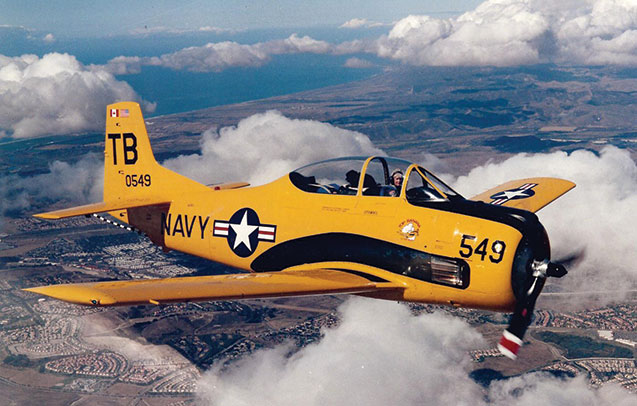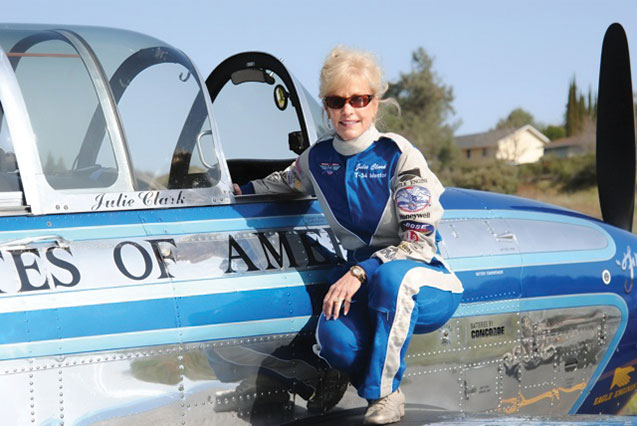Release #: Vol. 85, No. 2
March 01, 2016
Our Stories: Flying Phenom Julie Clark’s Career Continues to Soar
By John Perkinson, Staff Writer

Clark piloting her North American T-28 Trojan "Top Banana" named after Hughes Airwest's advertising campaign, "Top Banana of the West."
Anyone remotely familiar with precision aerobatics in the North American air show circuit knows the name Julie Clark. The former Northwest Airlines A320 captain has wowed audiences with her acrobatic prowess for decades, as she meticulously flies her Smokin’ T-34 Mentor or her T-28 Trojan through carefully choreographed maneuvers.
Nearly 68, the “first lady” of air shows has logged more than 33,000 hours aloft and secured ratings for 66 aircraft, all while assembling scores of accolades and hall-of-fame inductions. However, her true legacy may best be captured in the inscription of an award she received in 2012.
The Crystal Eagle from the Aero Club of Northern California acknowledges Clark as “one of the world’s foremost air show aerobatic artists,” but it doesn’t stop there. The trophy points out that she overcame “great personal adversity,” and that in pursuing her passion for flying, she helped “opened the flight decks of the major airlines to women pilots.”
“I’ve loved airplanes ever since the first time I went on a trip with my dad,” recalls Clark, who begged her mom to let her skip school. “I was only eight or nine, but after a day of flying in that DC-3, I was hooked.”
Her dad, Pacific Air Lines Capt. Ernie Clark, was her greatest inspiration. Sadly, he died in a tragic accident on May 7, 1964, when a suicidal passenger burst into the cockpit of his Fairchild F27, shooting him and the other pilot. The event resulted in an amendment to U.S. federal aviation regulations requiring an airliner’s cockpit door to be locked during flight.
As a teenager, Clark suffered the loss of both parents. She moved in with her aunt and uncle and later graduated from the University of California, Santa Barbara. After graduating, she went to work as a flight attendant for TWA. While temporarily grounded by a car accident, Clark realized what she really wanted to do was fly. In 1969, she earned her pilot’s license. A series of jobs helped her earn money to attain her instrument, commercial, and certified flight instructor ratings.
In 1976, she bought a Beechcraft T-34, “sight unseen” at a government surplus auction in Anchorage, Alaska, for $18,000. Remodeled and refurbished, it’s the same aircraft she flies in most of her shows.

Clark beside the cockpit of her Beechcraft T-34 Mentor
A year later, Clark went to work as a pilot for Golden West Airlines, having applied numerous times before finally being hired. She was the only female on the Los Angeles, Calif.-based airline’s roster of 110 pilots. By 1978, she was flying for Hughes Airwest.
Clark generated lots of attention because at the time she was one of only 20 women pilots employed by U.S. airlines, but she remained focused on her flying. In 1980, Hughes merged with Republic, which in 1986 merged with Northwest, the airline that Clark would eventually retire from.
Most of Clark’s flights were routine, but she remembers a particular incident during a takeoff out of Las Vegas, Nev., when her airplane blew a tire. Chunks of the tire hit the flap before being ingested into the right engine. The airplane’s hydraulics, brakes, and flaps—everything on the right side—stopped working.
“We couldn’t dump fuel in that old DC-9,” she said. “We were over gross weight, and it was very hot. We circled for more than an hour preparing for what we would have to do.” Eventually she and the first officer landed the airplane safely with no injuries, and the damaged airplane was towed to the gate. When the news media heard of the situation, journalists descended on the airport.
“The next day the headlines of one of the papers said, ‘Pilot of Disabled Jet Believed to Be a Woman,’” she recalls, chuckling that her gender was the most critical element of the story.
These days, Clark performs at a dozen air shows a year. “It’s an energy-management program, not the quick, high-power ratio show you see from some others,” she notes. A charter member of the International Society of Women Airline Pilots, Clark also spends time mentoring. She works closely with Women in Aviation International and other organizations, hoping that her work will inspire others to pursue aviation as a career. But most of all, she still loves to fly. As she readily points out, “Nowhere is there an office with a better view!”
Next Performance?
Visit julieclarkairshows.com to find out where Julie Clark performs next.
This article is from the March 2016 issue of Air Line Pilot magazine, the Official Journal of the Air Line Pilots Association, International—a monthly publication for all ALPA members.
-###-

